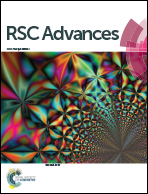Green recyclable SO3H-carbon catalyst for the selective synthesis of isomannide-based fatty acid monoesters as non-ionic bio-surfactants†
Abstract
A series of novel isomannide-based fatty acid monoesters 3(a–f) were synthesized by employing a highly active, water resistant and easily recoverable carbon-based solid acid catalyst derived from glycerol. The mannitol was reacted with decanoic, lauric, myristic, palmitic, stearic and oleic acids in the presence of a carbon acid catalyst under solvent free conditions to obtain corresponding isomannide fatty acid monoesters involving in situ dehydration of mannitol to isomannide followed by acylation. The optimized reaction conditions for obtaining isomannide monoesters are: fatty acid to mannitol mole ratio (1 : 1.5), catalyst 20 wt% of mannitol, temperature 180 °C and reaction time of 12 h. The carbon acid catalyst was recovered by filtration and reused for five cycles without losing its catalytic activity. The use of a recyclable solid acid catalyst makes this method more convenient, simple, and cost effective in addition to having a high selectivity with good yields. All the synthesized compounds were further evaluated for their surface active properties such as, critical micelle concentration (CMC), surface tension at the CMC (γCMC), surfactant concentration required to reduce the surface tension of the solvent by 20 mN m−1 (pC20), maximum surface excess (τmax), and the interfacial area occupied by the surfactant molecules (Amin) using surface tension measurements. The micellization (ΔG°mic) and adsorption free energies (ΔG°ads) were calculated. Isomannide monomyristate (3c) and isomannide monolaurate (3b) exhibited superior surface active properties followed by isomannide monopalmitate (3d) compared to other isomannide monoesters.


 Please wait while we load your content...
Please wait while we load your content...